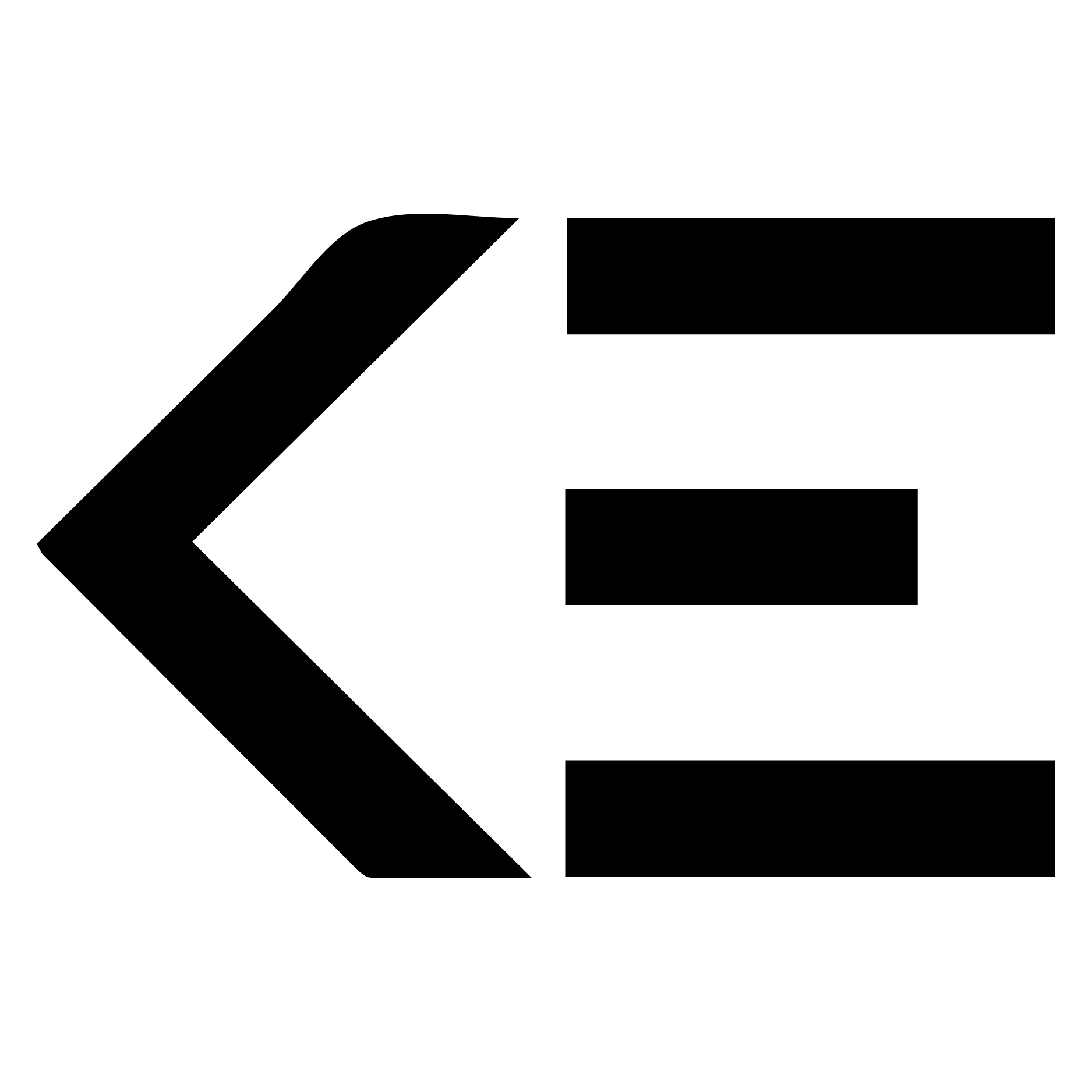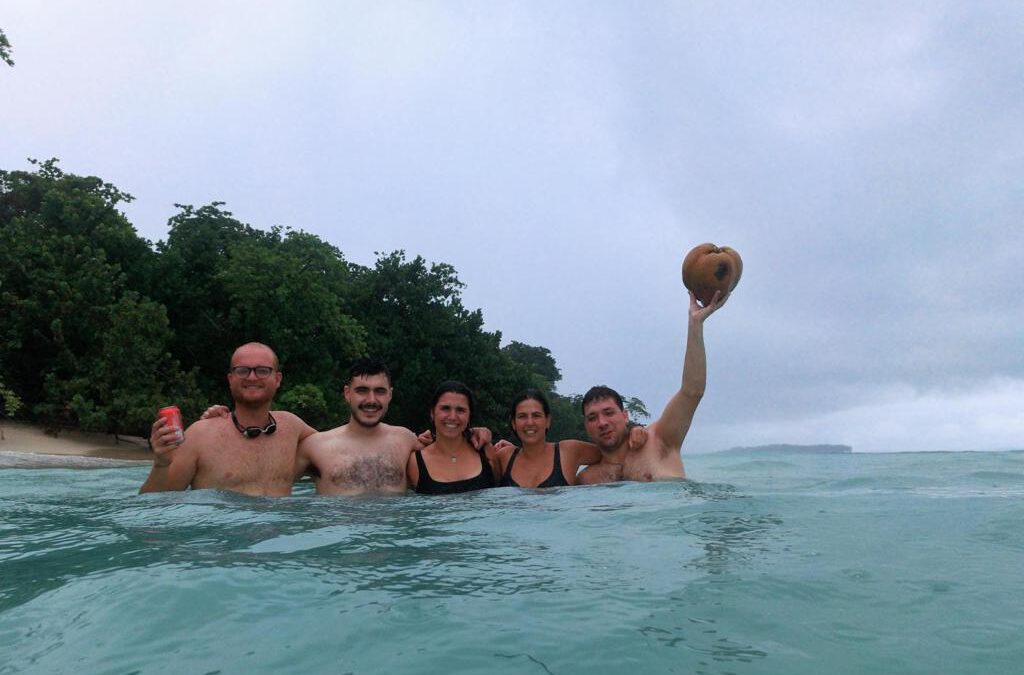Panama was mainly a transit country for me, because Marieke was travelling back from Costa Rica and just two weeks later I had a date with my sister in Colombia. But it was exactly the travelling that made Panama so exciting. So in this post I write a bit about the Panama Canal and how I hitchhiked through it in a sailboat.
In the next blog post, I’ll write about the Darién Gap and how I travelled from Panama to Colombia by boat in 4 days to avoid flying. Because between Panama and Colombia there is such an insurmountable mountain range with rainforest that there is no road across the border!
If you are interested in the Darién-gap, how to cross it in boats and why it is dangerous for refugees, then checkout this blog entry.
Two Paradise Places in Panama
Before I get to the Panama Canal, first a report on two beautiful places I visited in Panama.
I crossed the border into Panama from Costa Rica in the northwest. So a visit to the islands of Bocas del Toro was a good idea.
Bocas del Toro is the name of a region of Panama and its capital on the island of Colón. But travellers usually use the name synonymously for the islands of the region.
A short digression: one island translates as Columbus, another as Christopher. I find it frightening and disconcerting that there are many places in Central America that are still named after Columbus, after the suffering that he and the Spanish brought. This is a clear sign that history is far from having been dealt with. For example, the currency of Costa Rica is also called Colón and there is a bus line from Guatemala called Cristobál Colón.
Fortunately, there are many other islands in the corner and the most beautiful ones had other names.
I arrived on a Thursday in the town of Bocas del Toro, which is known for its nightlife, and had to decide right away if I wanted to join the legendary Filthy Friday: every Friday, there is a very popular party on three different islands, which is celebrated as the best party in Central America (among tourists) with the Sunday Funday in Nicaragua. The party starts at 11 am and you are driven to different locations. In the end, the price of 45 dollars (drinks not included, only shots) kept me away. I would have found it exciting, but I probably would have raised the age average 😀
At the same time, I met a group of four super cool Spaniards with whom I went on a boat tour and then partied in the evening. The boat trip was super cool and we got along very well. The highlight was the breathtakingly beautiful island “Zapatillos”, where only the 12 people from our boat were! I played the guitar on the boat trips and we also went snorkelling. Since the food was super expensive and I had no preparation time, Ines, Monika, Azier and Pablo shared their lunch with me. The 4 of them were really super sweet and we spent some time together the next day too!
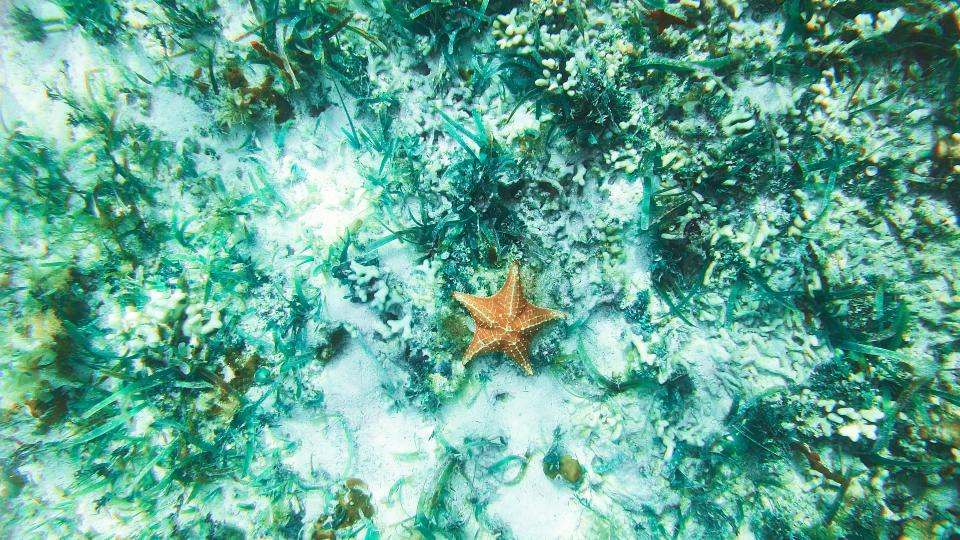
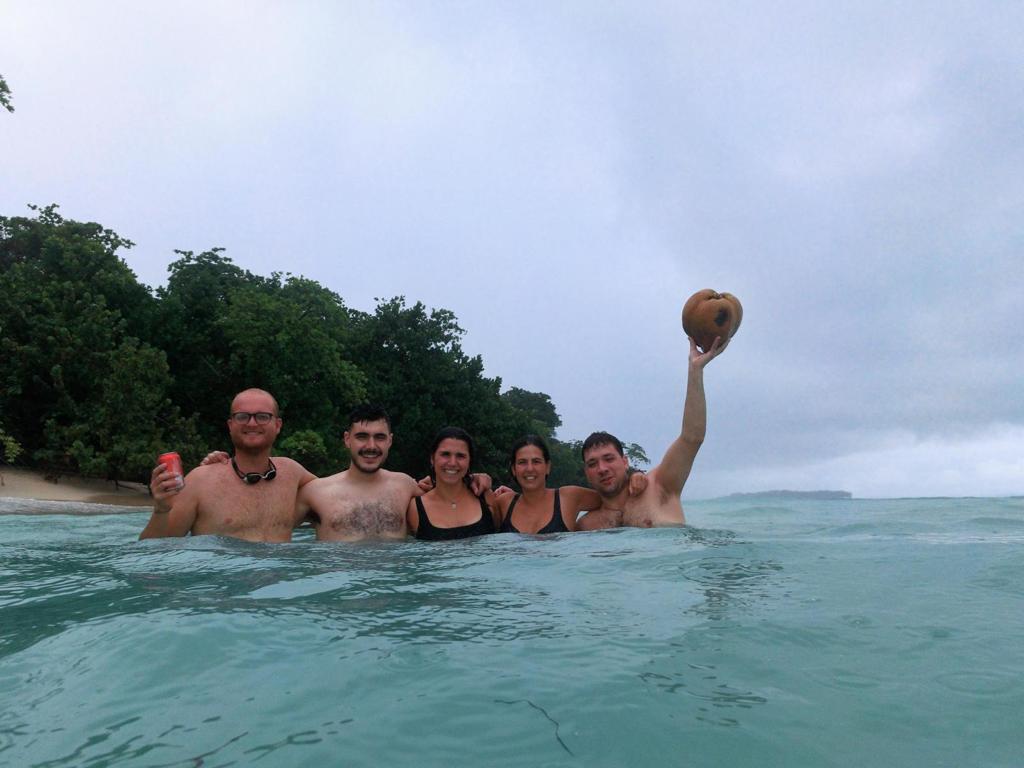
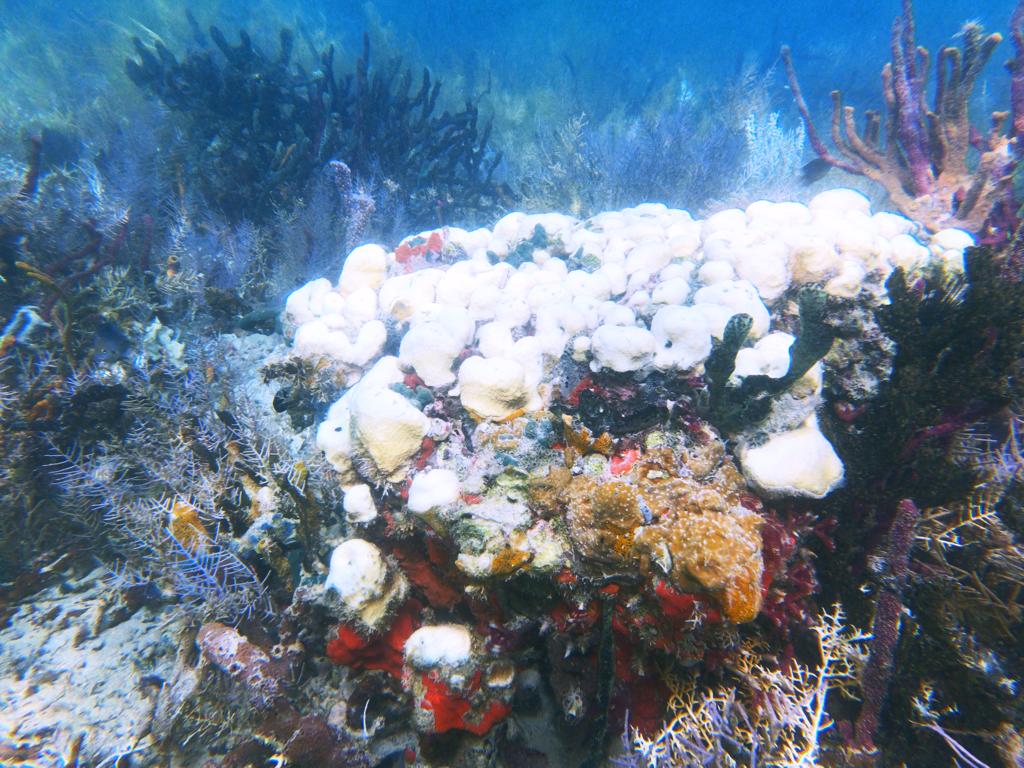
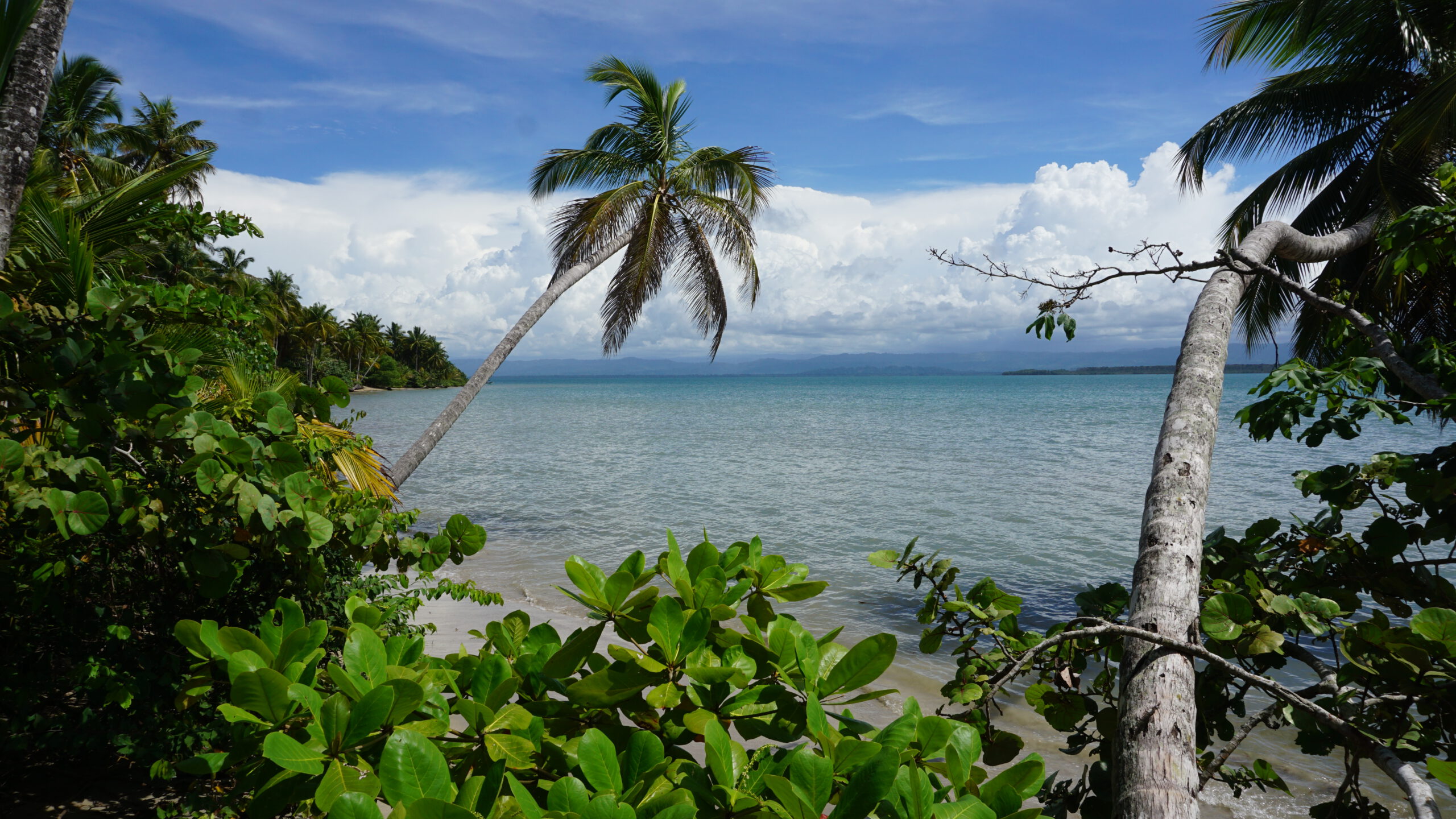
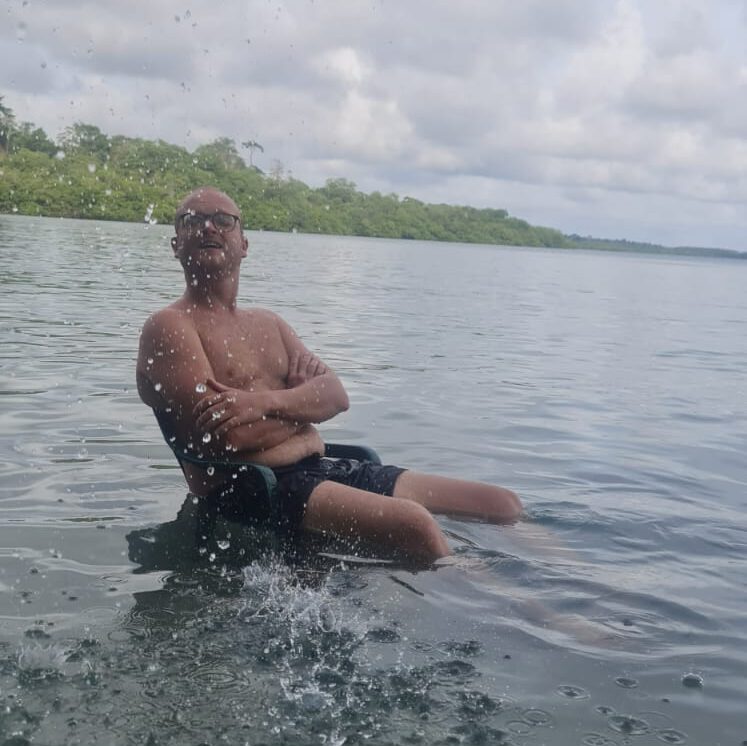
On the second full day, I explored Colón Island and did a beautiful hike to Starfish Beach. All the beaches along the way were empty and paradise-like. Only the starfish beach itself was full of tourists who are brought here in boats. But I could see really big starfish 🙂
In the evening, I met Alessandro from Switzerland, whom I had met in Costa Rica, and after a second long evening in Bocas del Toro, I drove on to the Lost & Found Hostel the next day. The hostel was started a few years ago by two Canadians and is located in the middle of the rainforest at an altitude of 1250 metres. Since I had heard a lot of good things about the hostel and I like remote hostels because of the family atmosphere, I stopped by for two nights and had a very good time. Located in the middle of the jungle, but at the same time in the mountains, the hostel offers really fantastic views and great hiking opportunities. In the evening, all the guests have dinner together.
The first day I chilled in the hostel and did a short hike in the rainforest and the second day I went on a trip with 4 other travellers: first to a beautiful 40m high waterfall and then to a small natural canyon to cool down. At the waterfall we were the only ones and at the canyon there were about 10 other people, so we really enjoyed these two wonderful places!
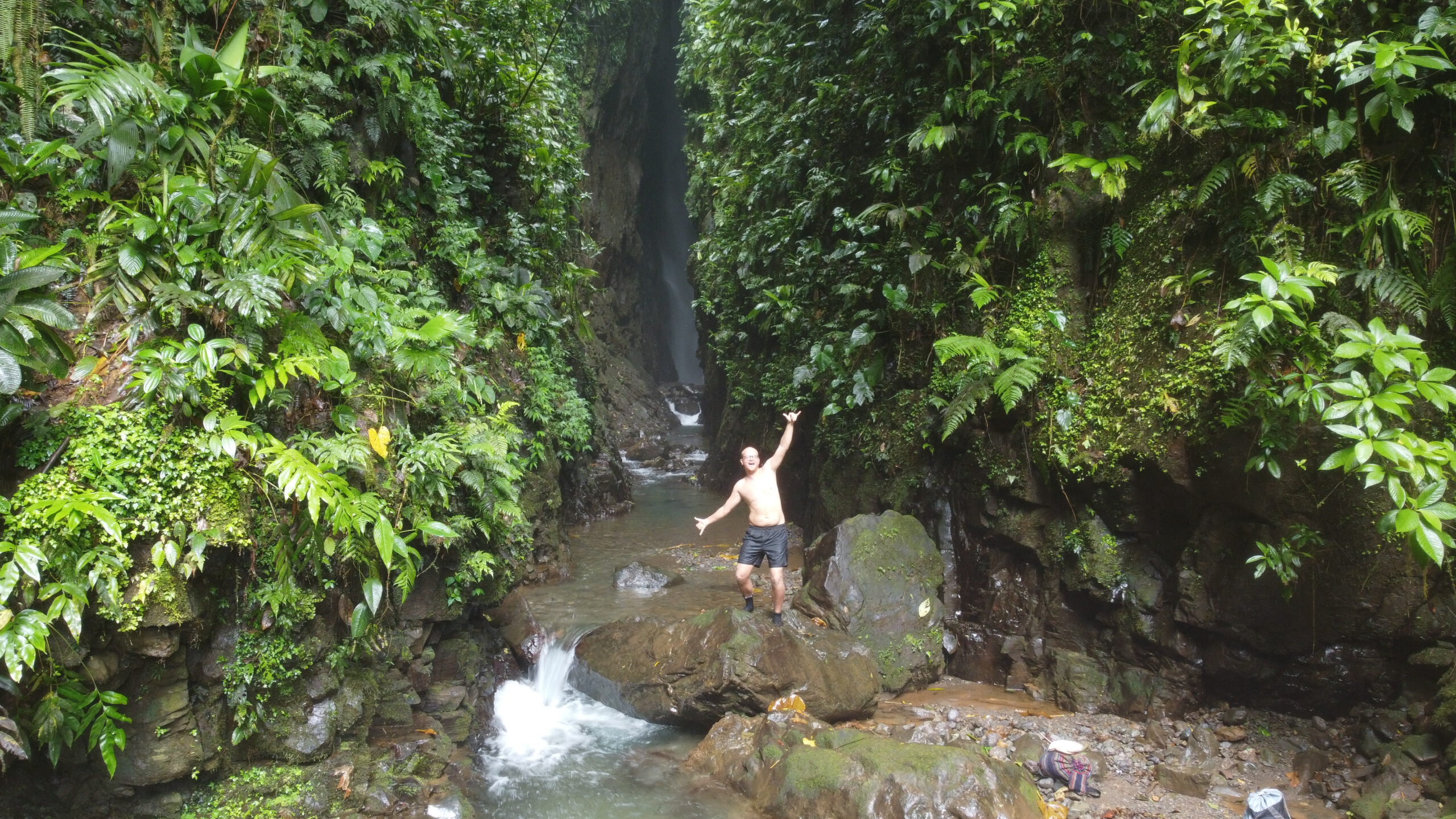
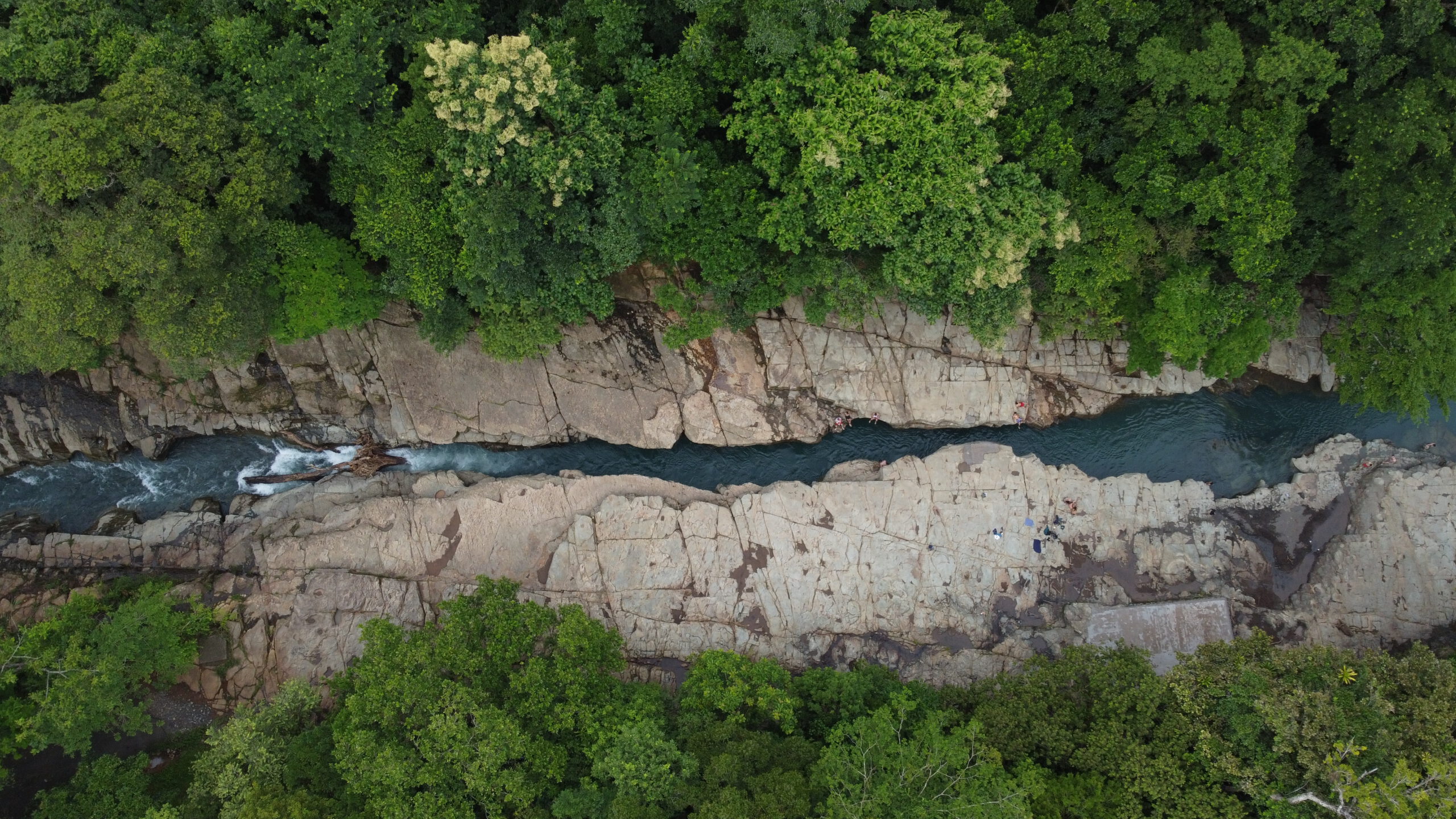
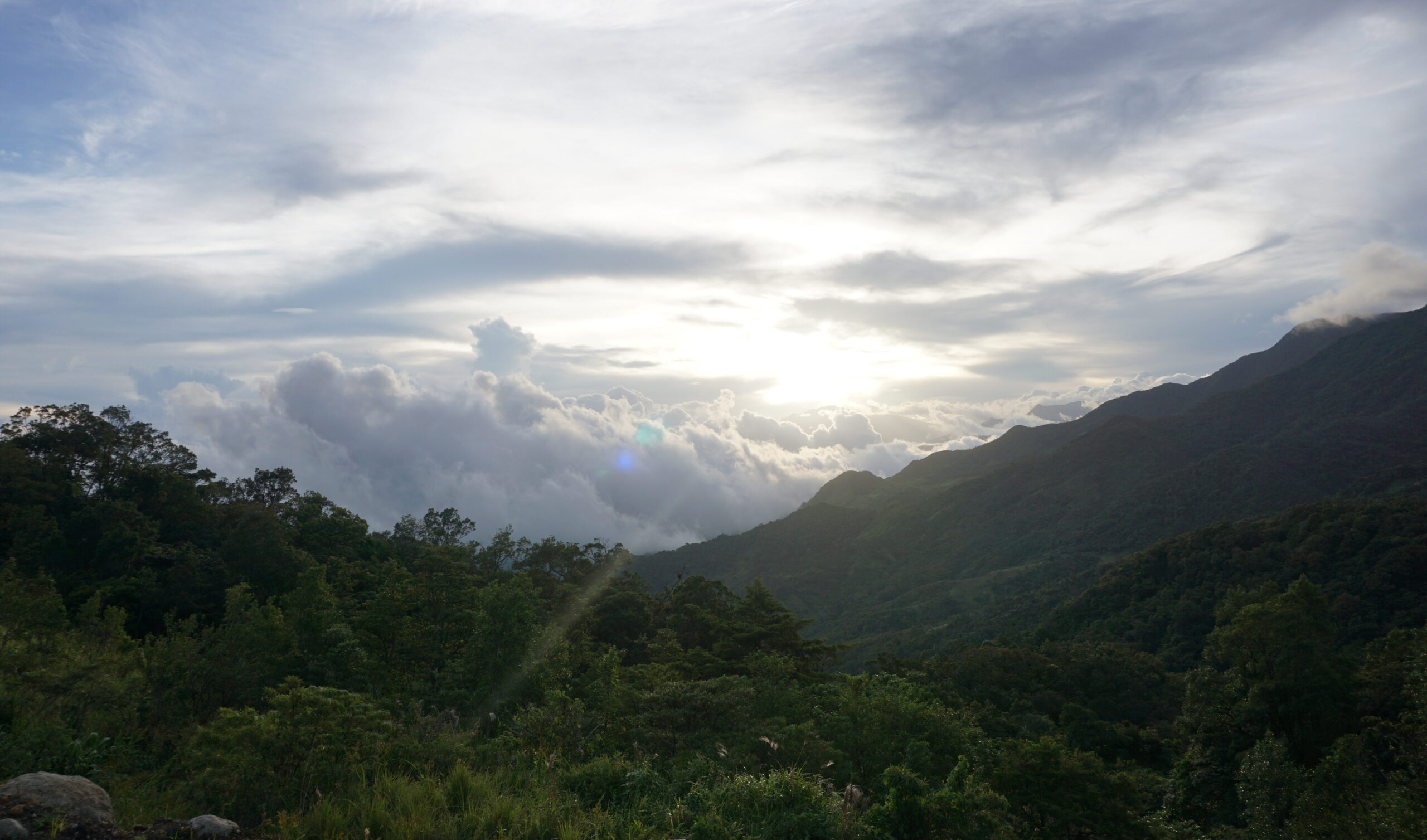
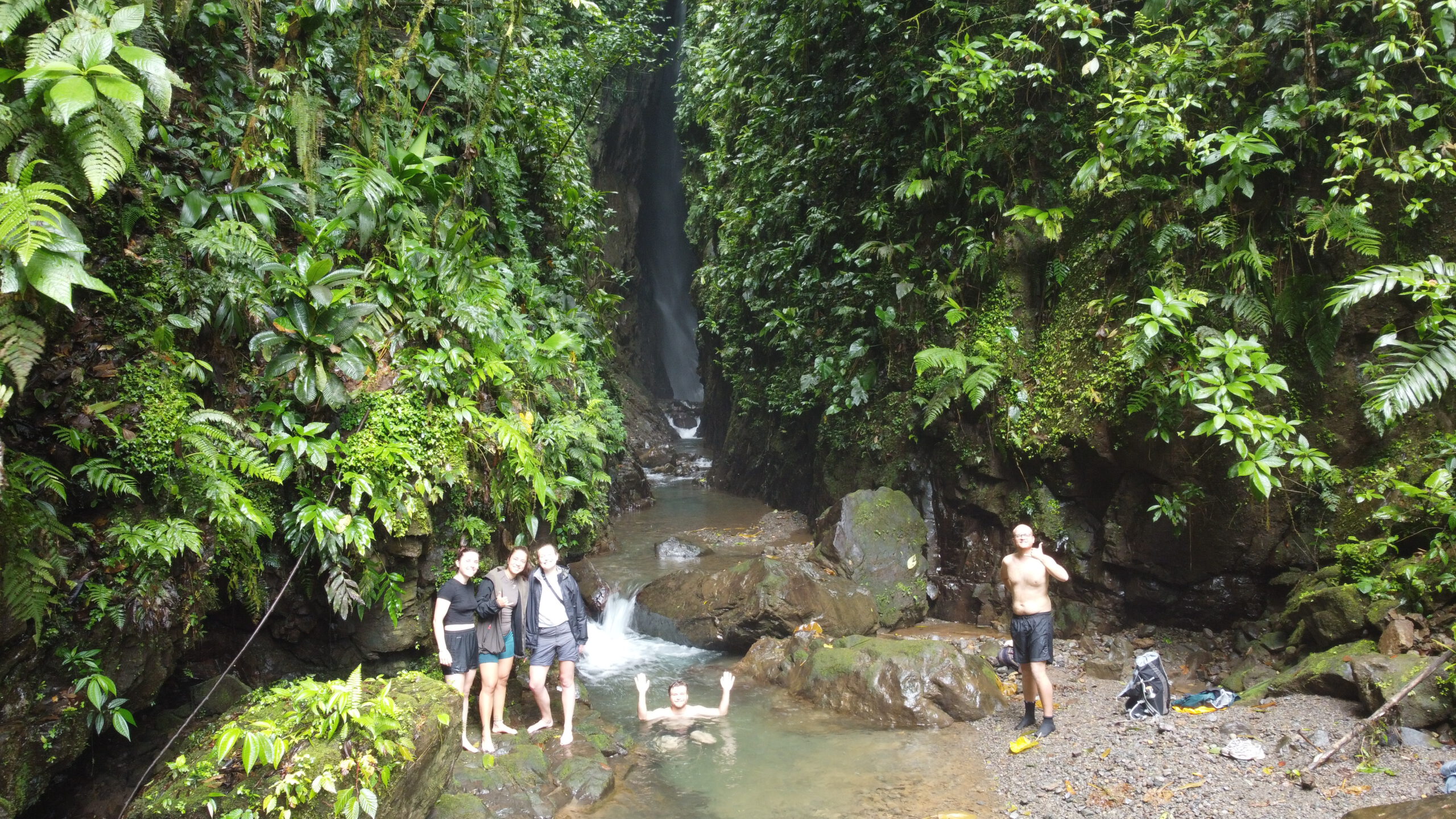
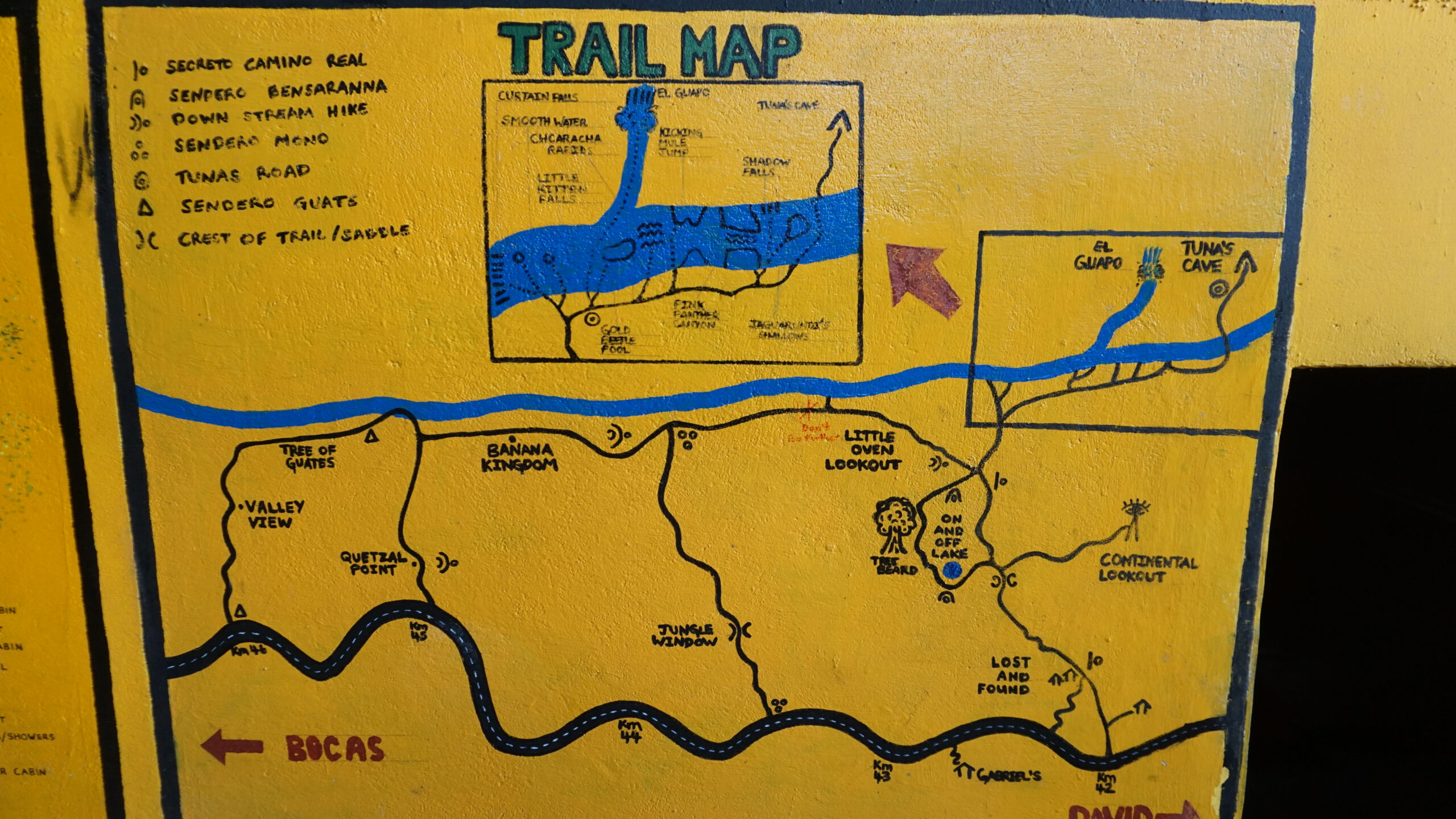
From Lost & Found, I hitchhiked in the evening to the city of David, where I met Alessandro one last time and then took the night bus to Panama City.
The Panama Canal and its difficult history
Shortly after the Spanish arrived in Costa Rica and Panama, the officer Vasco Nunez de Balboa discovered the Pacific Ocean, which he then called the “Southern Ocean”. That’s what many texts say, but of course it’s bullshit. Thousands of indigenous people had already seen the Pacific before him, but they were not white Europeans. In fact, Balboa was only able to travel to the Pacific through the descriptions of indigenous people.
Be that as it may, it was only a short time later that the idea of a canal through Central America first arose. At that time, however, a breakthrough in Nicaragua was actually favoured, as it would be possible to reach Lake Cocibolca via the Rio San Juan, and then only about 20 km would have to be bridged to the Pacific.
However, it was to take almost 400 years before the idea of a canal through Central America became a reality in Panama. The fact that it did not happen in Nicaragua was mainly due to border conflicts with Costa Rica at the time, as the San Juan River separates the two countries. And of course, the interests of the USA played a major role, which helped Panama gain independence at the beginning of the twentieth century and was able to assert its influence there more clearly.
In 1881, a French delegation began construction of a canal with the consent of Colombia, to which Panama still belonged at the time. After the economic success of the Suez Canal, opened in 1869, many in France assumed that it would be similarly possible to build a lock-free canal in Panama. But after many discussions in parliament and several investment extensions, they had to realise that it was not possible without locks. Together with Gustave Eiffel, locks were then to be built. But in 1889, the French finally stopped the construction work after planning deficiencies, wrong geological investigations, bad planning, bribery and numerous mishaps. Last but not least, a mass death contributed to this. At least 22,000 people died of malaria or yellow fever during construction between 1881 and 1889, diseases that were not yet known or researched at the time. French doctors recommended that workers’ bedposts be placed in buckets of water, but these buckets became breeding grounds for the malaria mosquitoes, which only made the spread more rapid.
For 3 apples and 1 egg, the US bought the previous advances from the French canal company in the late 19th century. When Colombia objected and refused to allow the USA to build the canal, the USA marched unceremoniously into what is now Panama and declared its independence (of course, this is a somewhat abbreviated version, but that is roughly what happened). In the so-called Hay-Bunau-Varilla Treaty, the USA secured unrestricted control of the entire canal area of approx. 84,000 hectares, which it only ceded in full to Panama in 1999. In return, they guaranteed Panama’s independence.
In 1914, the USA finished construction work on the canal and the first ship to cross the canal was a small freighter named “Cristobal” (as usual). On the same day (3 August), the First World War broke out, so the celebrations were postponed.
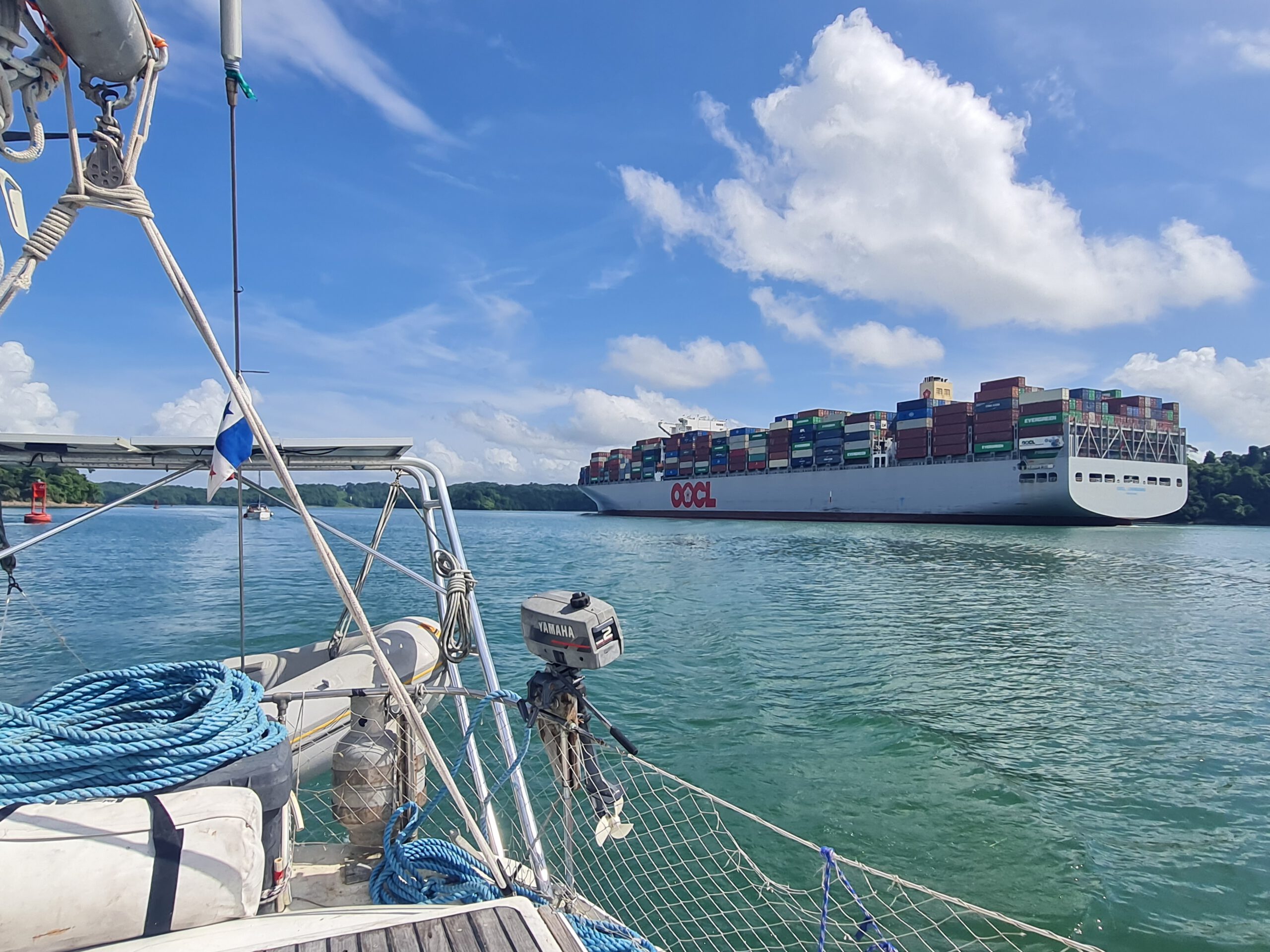
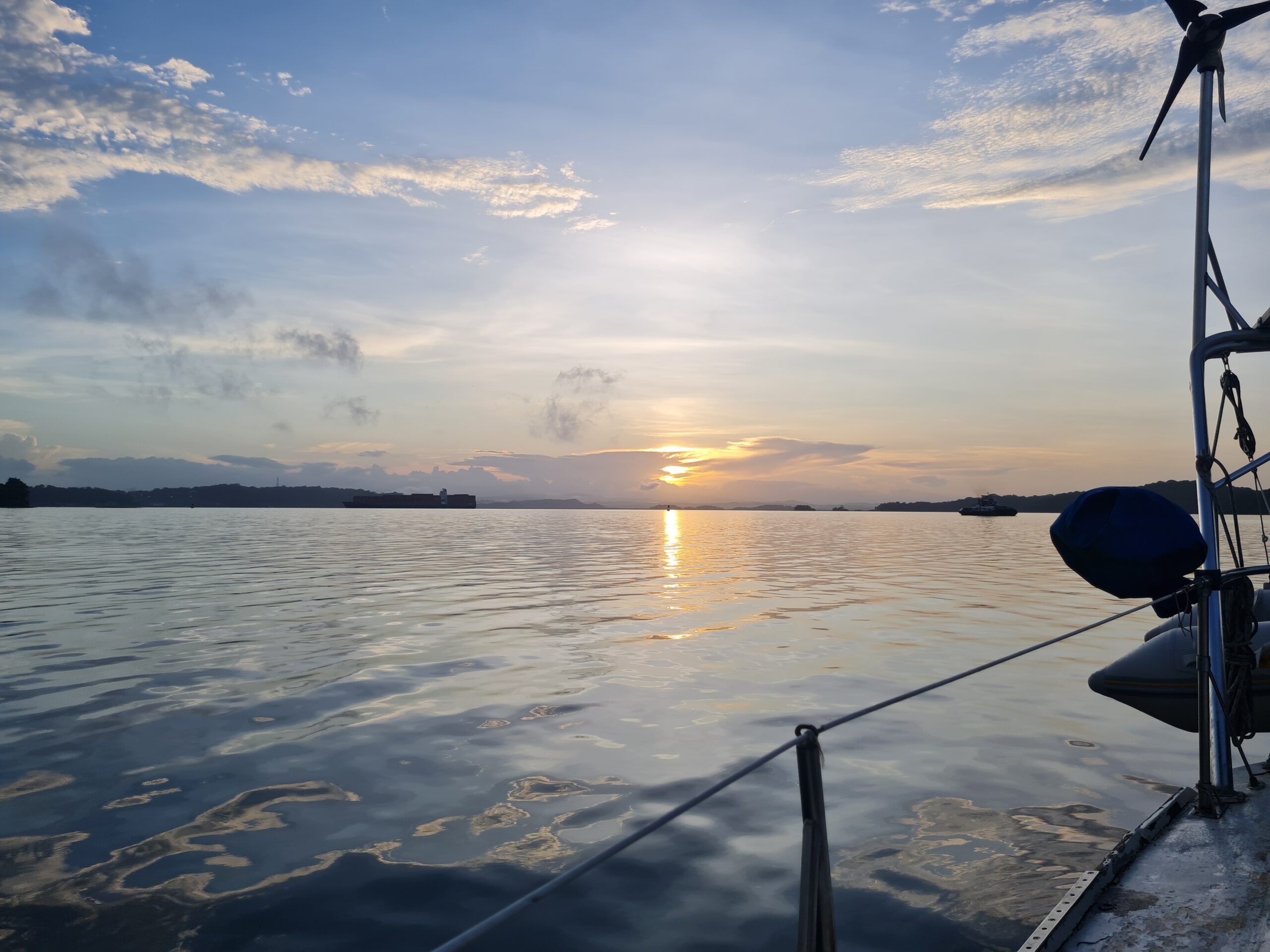
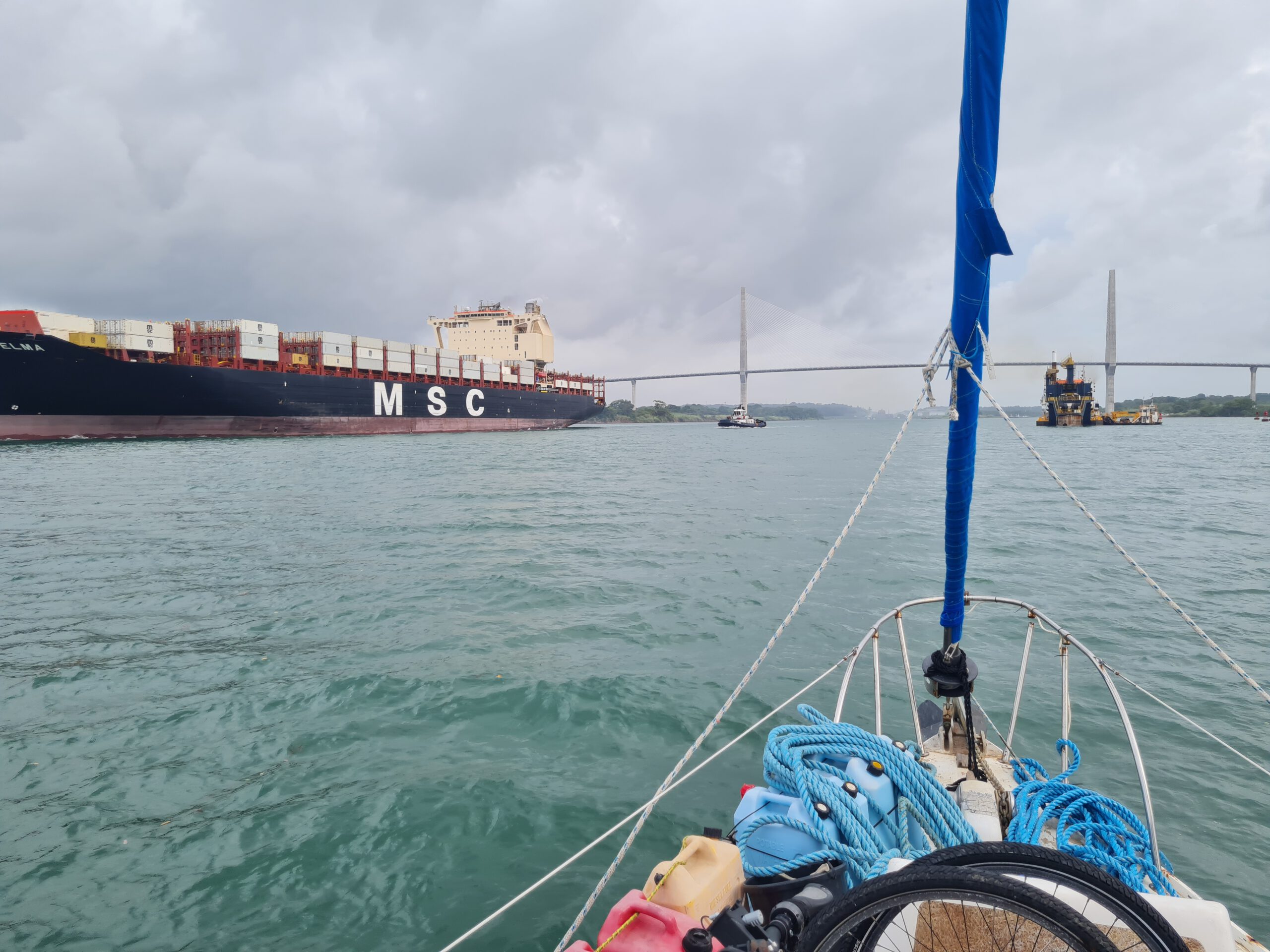
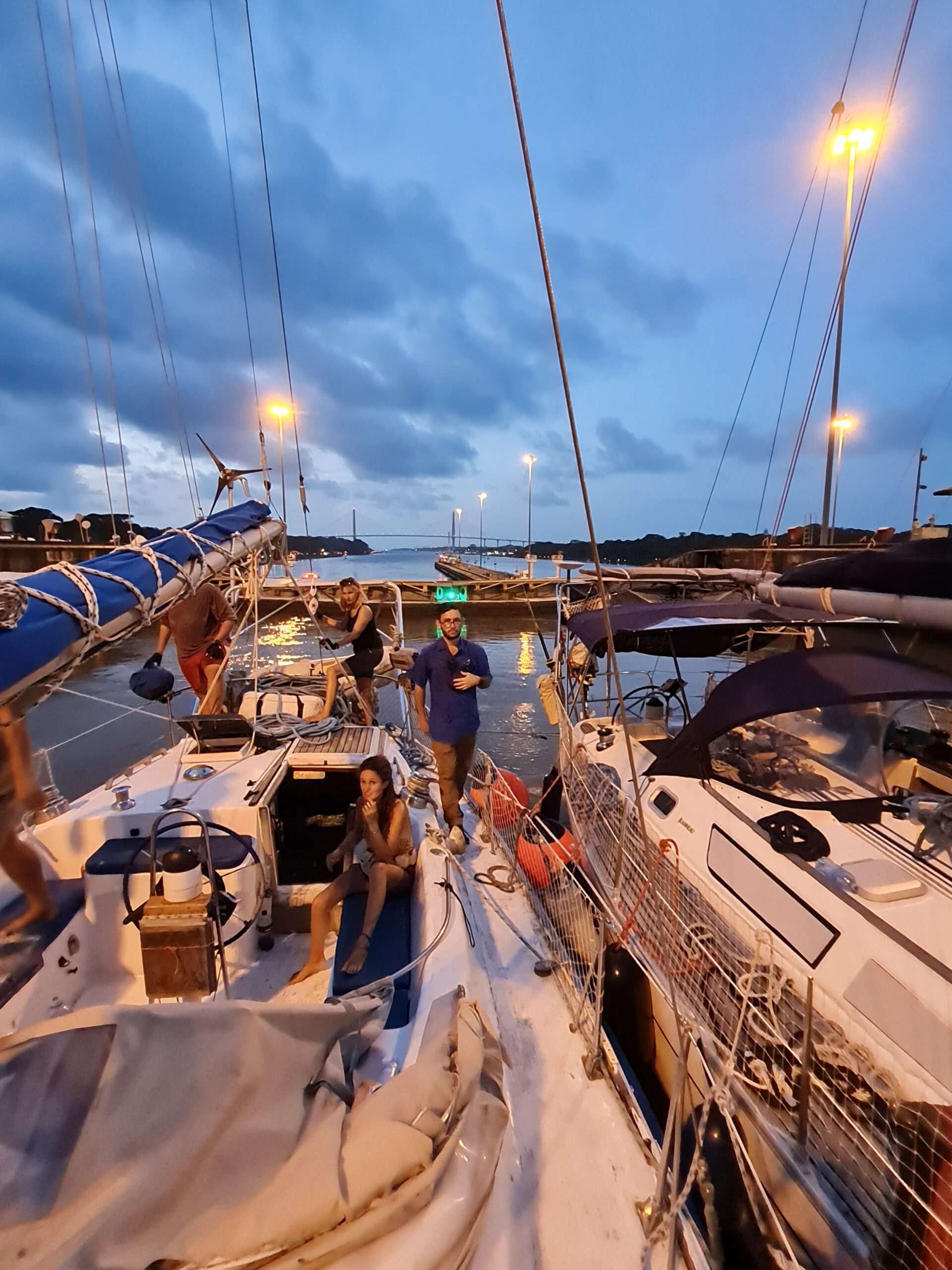
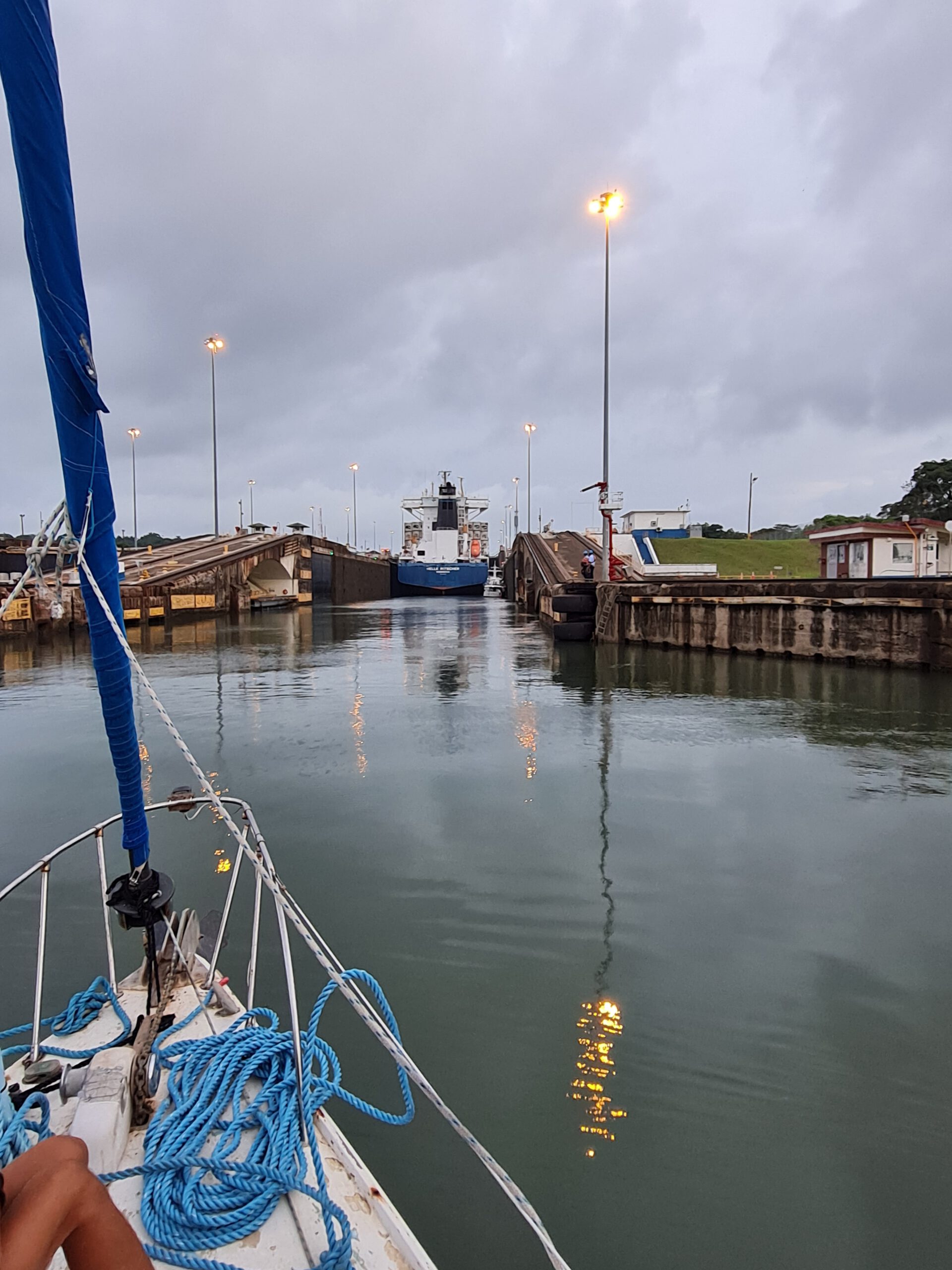
The canal quickly became very busy and has become one of the most important waterways in the world, indispensable for world trade. The lack of alternatives to the canal is also noticeable in the exorbitant prices to cross it (about 2000 dollars for a sailboat alone), from which mainly the USA profited for decades. Today, the canal is by far the most important source of income for Panama and ensures that the capital, with its many bank towers, does not look like a classic Central American capital.
Off through the canal
To cross the canal, you have to go through 3 locks up into Gatun Lake, then travel 82km and then 3 locks down again. To allow ships to sail in both directions at the same time, there are a pair of locks in each direction. In addition, newer locks were completed a few years ago, so that there are 18 locks in total, but as mentioned, you only pass through 6 of them.
Depending on the time of day you cross the canal (you have to register days in advance), you anchor and spend the night in Gatun Lake and the pilot comes back on board the next morning. It’s a bit different for container ships, which usually also sail through at night, but then pay more for the pilot who works at night. This is because container ships are much faster than sailing boats through the Channel, and the aim is to arrive at a destination as quickly as possible in order to deliver goods worth enormous sums of money.
A pilot is compulsory, by the way, and one of the reasons why it is so expensive to cross the Channel. In shipping, a pilot is a person who comes on board a ship to give advice on how the ship should manoeuvre for a difficult passage. This can be the entrance to a large harbour or even a canal.
All quite exciting, I thought, when I came to Panama and I knew I wanted to try to go through the canal in a boat. I didn’t have much time, but I was very lucky 🙂
When I arrived in Panama City, I just put my things down and went to Shelter Bay Marina, which, unlike Panama City, is on the Caribbean side of the canal. The marina is quite remote and was inconvenient to get to and could only be reached by hitchhiking (taxis were out of the question for me, both because of the price and for environmental reasons).
When I arrived at the port at 1pm, it took me only an hour to find a boat that was going into the canal the same day. I got on well with the captain, Henrik from South Africa, but he then told me that he had already signed up 5 people for the canal. But when I talked to his crew for a while on the jetty and had a good chat with them, he fortunately changed his mind and it was no problem afterwards that there was one more person on board. Half an hour later at 3pm we were off! Together with Steven, also from South Africa, Louise from England, Laura from France and Max from Germany, we made our way through the Channel. Max and Laura also hitchhiked across the Atlantic in sailboats and we have some mutual friends. So we got along great and had a good time.
The trip through the canal took longer than I thought, because the pure travel time is about 8 hours. We had to wait for the pilot at the locks for about 2 hours, so it was already dark when we went through the locks. The locks are definitely the most exciting part of the canal. We went through the locks together with a large container ship, a motor yacht and a sailing boat. The container ship in front of us, so it couldn’t be pushed on us from behind. We went through with the other sailing boat in a pack, which means that we tied ourselves to each other. So, as the right-hand of the two boats, we only had to take two lines from starboard and the other boat only from port. The lines are attached to our boat and to the edge of the lock so that we are not pressed against the walls in the strong current created by the inflowing water. On the container ships, these lines are not handled by people but by large machines that run alongside on rails.
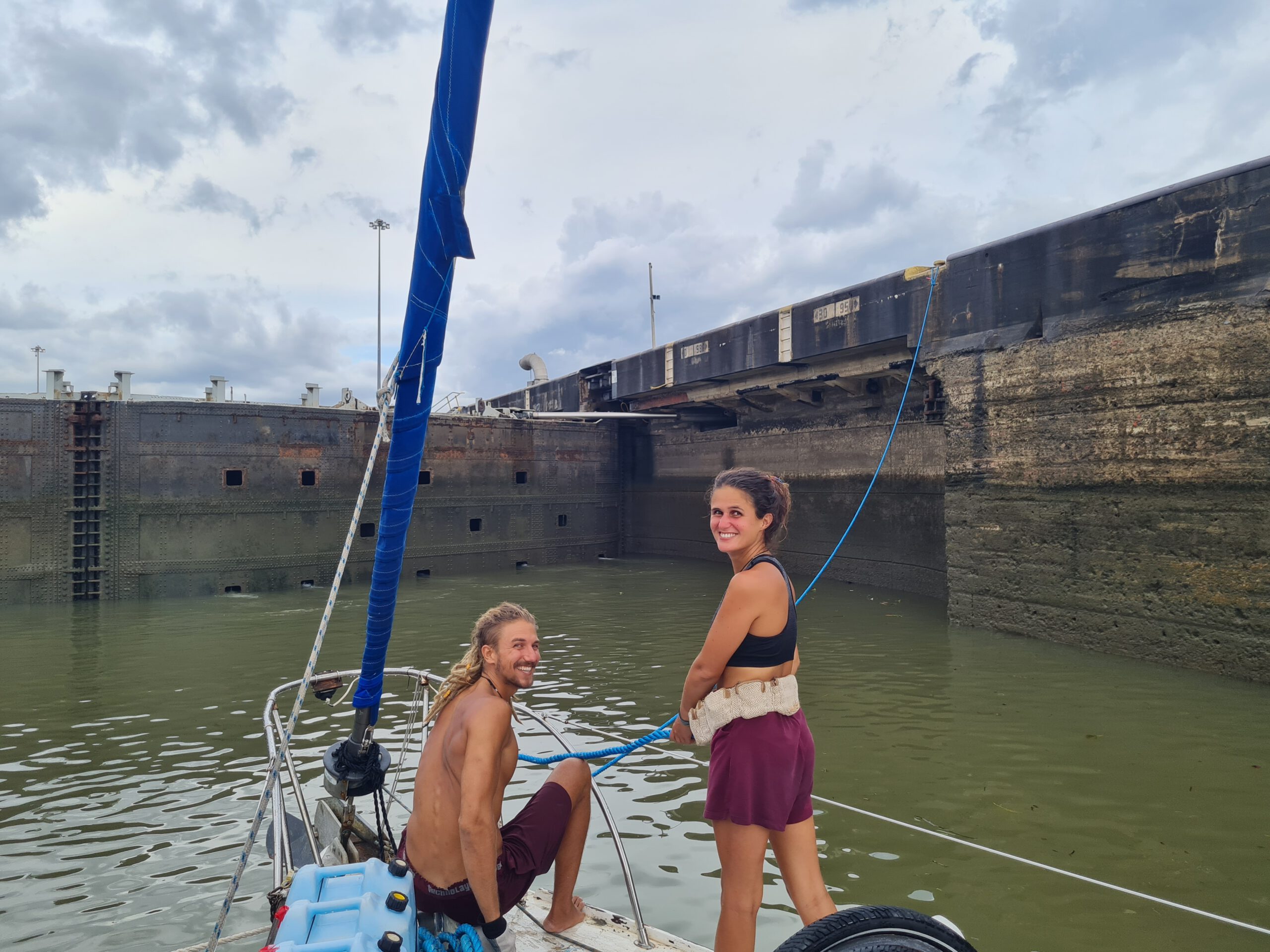
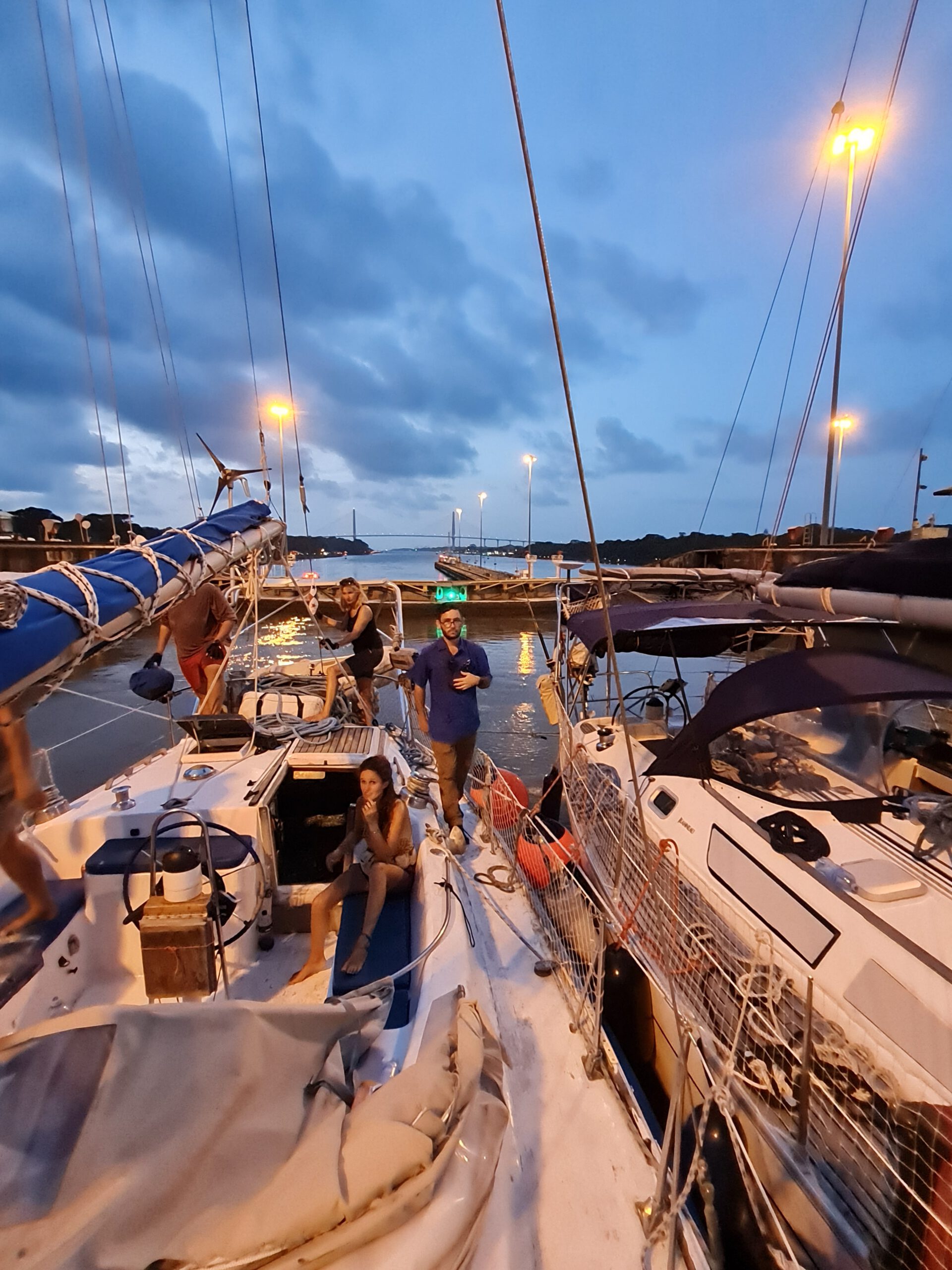
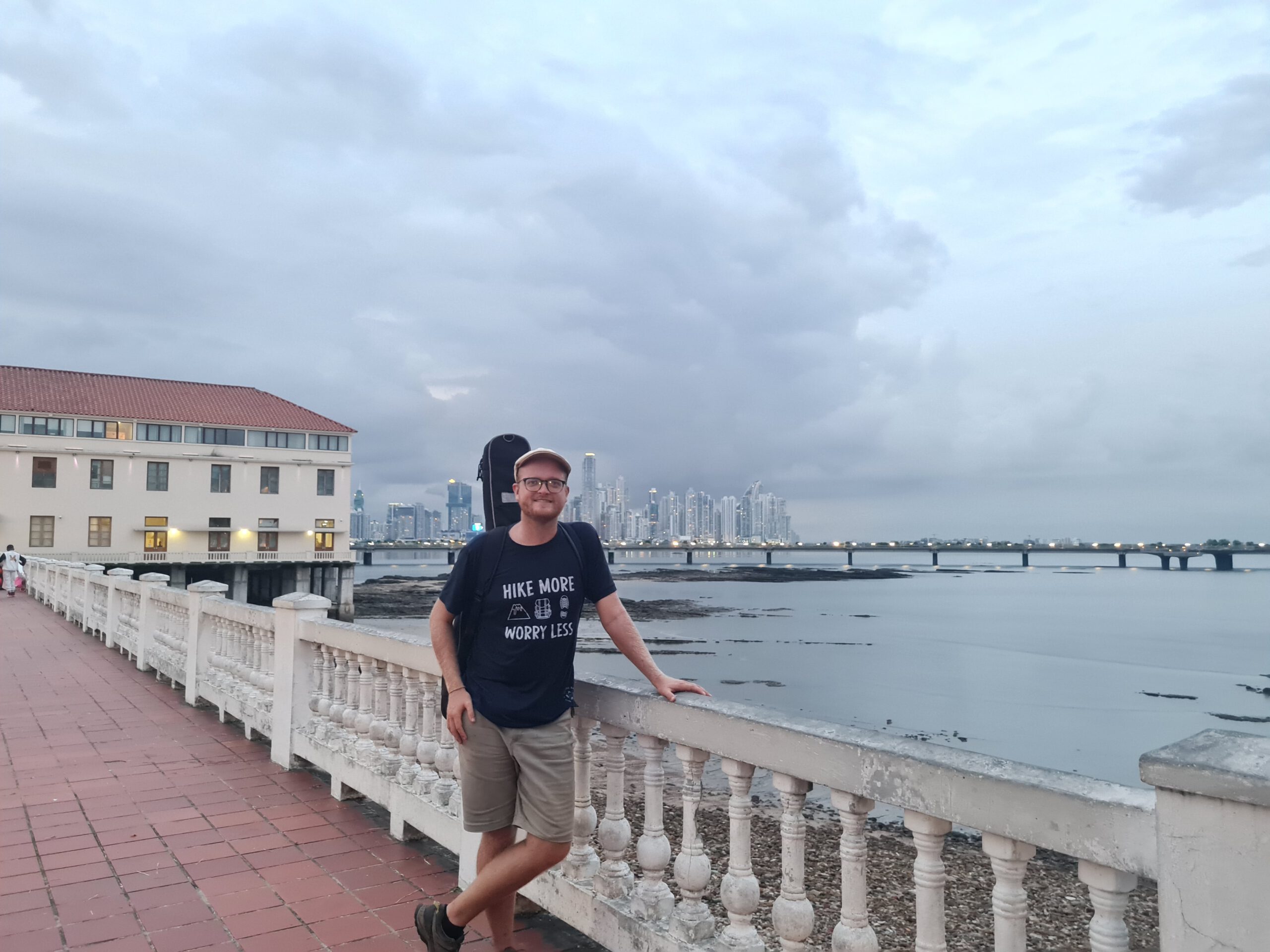
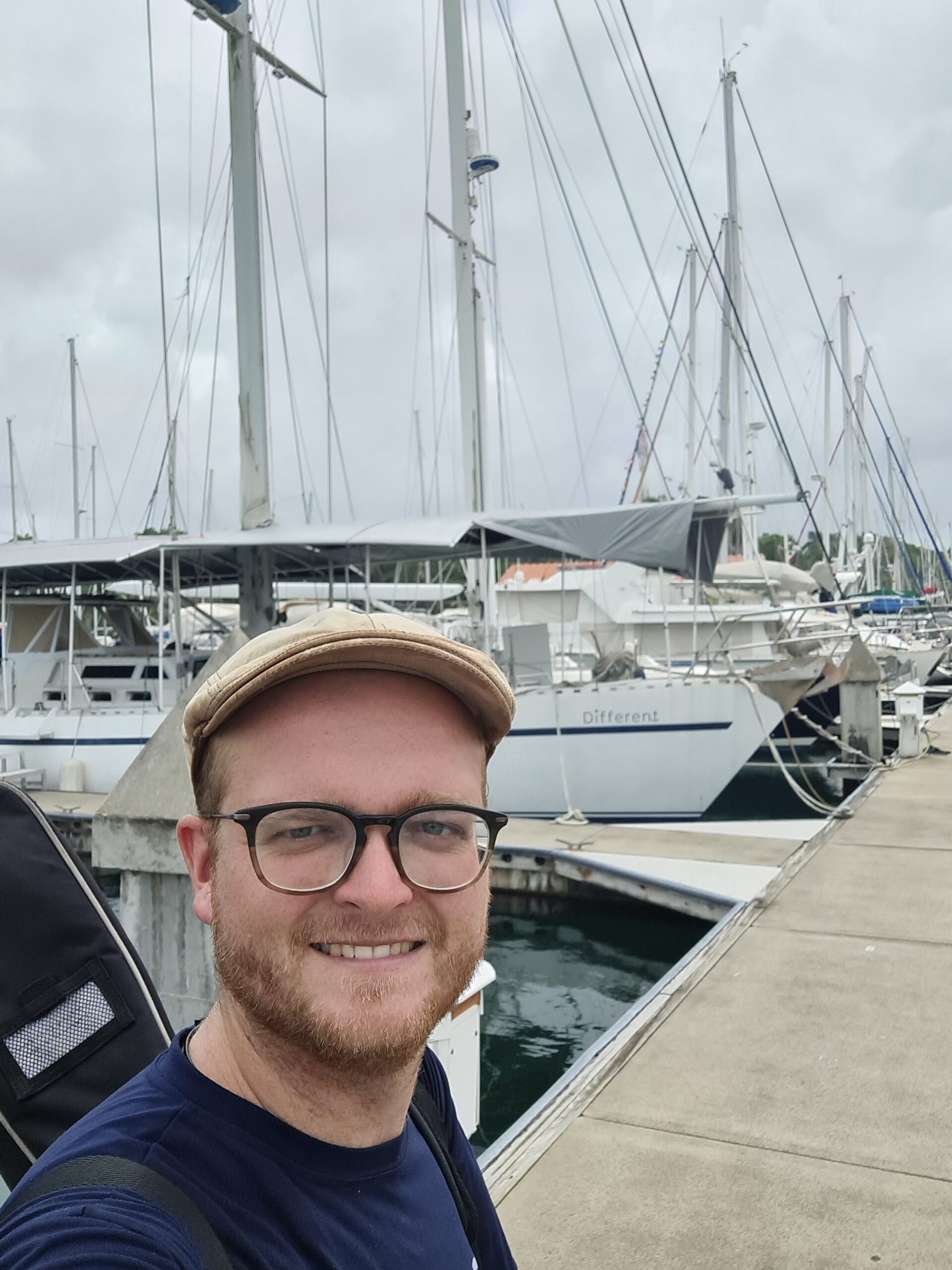
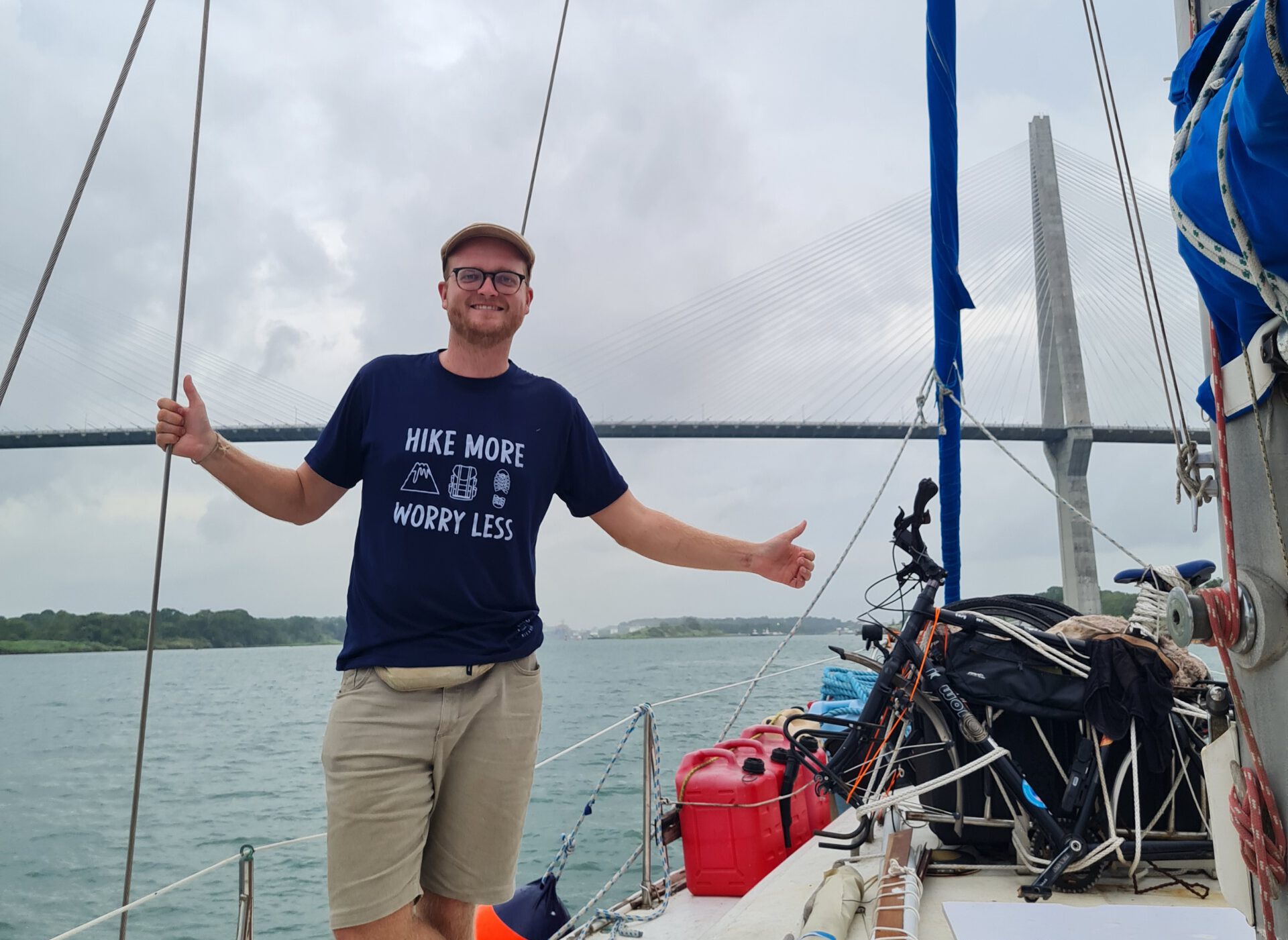
When we had passed the three locks and were about 30m higher, we sailed to a buoy where we moored for the night and the pilot disembarked. The next morning we were supposed to be ready at 6:30am and got up early, but we had to wait until 9am for the pilot to come and then we still had to sail the 82km through the canal. So we didn’t arrive at the locks until around afternoon, which then took us down into the Pacific. Here we were watched by many tourists from a grandstand and as the currents are different when going down the locks, this time there was a big container ship behind us instead of in front of us. Our view over the locks was phenomenal.
All in all, the trip through the canal was an absolutely thrilling experience and a real highlight for me as a sailor! It’s impressive what engineers were already able to build at the b
